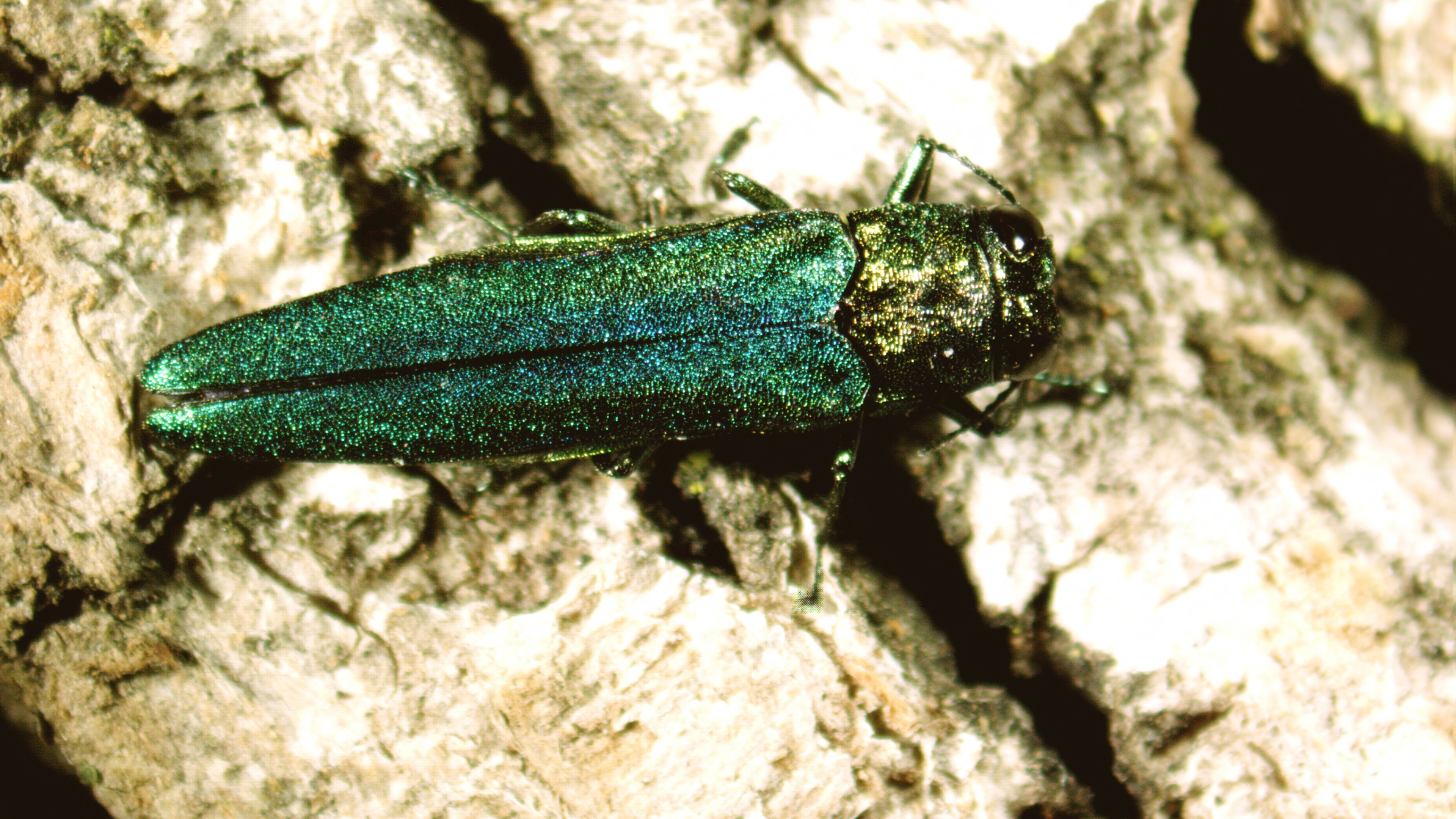Emerald Ash Borer

The emerald ash borer (EAB), an invasive wood-boring beetle from Asia, is responsible for the death and decline of tens of millions of ash trees in North America. EAB lays its eggs in the bark crevices of ash trees. The eggs hatch and the larvae burrow into the tree where they feed. This feeding is what damages the trees. We have detected EAB infestations in 36 States and the District of Columbia.
EAB is difficult to detect early when pest populations are small because damage to the trees is hidden under the bark and tree decline is gradual. The beetle is well-suited to our climate, is a good flyer, and spreads naturally. People contribute to the long-distance spread of the beetle when they move EAB-infested ash firewood, logs or nursery stock. EAB was first detected in North America in 2002 in southeast Michigan.
This invasive insect can attack and kill healthy ash trees in forests, and urban, suburban and rural settings. Here's what to look for:
Appearance
- EAB adults are metallic green with a coppery-red abdomen and about one-half inch long.
Signs of infestations
- EAB larvae burrow into the tree and feed on the inner bark and phloem and creating S-shaped markings. They pupate in winter and emerge as adults in spring, leaving D-shaped exit holes. The adults remain active until the end of summer.
Activity
- Adult beetles live for about three weeks. They are most active during the day, particularly when the weather is warm and sunny. To weather storms, they move to protected locations in bark crevices or cling to foliage.
Damage
- Symptoms of an infestation may include dead branches near the top of ash trees, excessive branching on tree trunks and vertical cracks in tree bark.
Woodpecker Activity
- Woodpeckers peel off the outermost layers of bark and punch their beaks through the remaining bark to eat larvae. If you see an increase in woodpecker activity, you may have EAB-infested trees.
Buy only local firewood or certified heat-treated firewood. Firewood can potentially harbor invasive pests or diseases that could threaten our forests, natural resources and the communities where we live, work, and play. Visit DontMoveFirewood.org for more information.
Treatment options are available at local retail outlets. Also, your local Cooperative Extension Agent is a resource if you are considering treating your ash trees.
Report Signs of EAB
If you think you've seen the pest or ash tree damage caused by an EAB infestation, please complete the form below. If you have questions or need additional assistance, call 1-866-322-4512.
Related Resources
We work with other Federal organizations, State Departments of Agriculture, Native American Tribes, and university partners to combat EAB and maintain ash tree species in North America. We rear and release biological control agents (stingless wasps) to manage the pest. In addition, we are researching the use of integrated pest management practices to reduce and control EAB in both urban and forest settings. These practices use a combination of tools and strategies to identify, manage, and reduce the risks and impacts from pests.
- Ash Range Map (7.64 MB)
- Biocontrol Release Map (3.43 MB)
- Biocontrol Recovery Map (3.31 MB)
- Emerald Ash Borer Known Infested Counties (interactive map)
- Emerald Ash Borer Infestation Time Series Spread Map
The goal of the EAB program is to help maintain ash trees as part of the North American landscape. We are focused on EAB biological control, detection surveys, and public outreach and education.
Questions and Answers: Release and Recovery of Biological Control for Emerald Ash Borer (385.5 KB)
APHIS removed its domestic EAB quarantine regulations in 2020. The final rule was effective January 14, 2021.
Program Manual (4.71 MB)
Biological control
- Biological Control Release and Recovery Guidelines (6.27 MB)
- Questions and Answers: Biological Control for Emerald Ash Borer (259.87 KB)
- Questions and Answers: Release and Recovery of Biological Control for Emerald Ash Borer (385.5 KB)
Survey and Trapping Guidelines
- Emerald Ash Borer Trapping Guidelines (1.24 MB)
- Trapping Protocols (2.09 MB)
- Trapping Materials List (166.09 KB)
- Pre-Survey Data Spreadsheet (69.5 KB)
- Survey Data Spreadsheet (74.5 KB)
- Debarking Ash Tree Logs to Look for Emerald Ash Borer
Training Videos
- Module 1 – About emerald ash borer, background, life cycle, how to identify, history of biological control, identifying ash trees, impacts of parasitoids, a quiz on tree species and insect identification, and more. (1 hour 40 minutes)
- Module 2 – Mass rearing of parasitoids, choosing release sites and release considerations, conducting releases, and introduction to MapBioControl. (1 hour 47 minutes)
- Module 3 – Evaluating parasitoids establishment, debarking and peeling trees, using yellow pan traps, a quiz on tree peeling and yellow pan trap, and identification questions. (2 hours 21 minutes)
Firewood can potentially harbor invasive pests or diseases that could threaten our forests, natural resources and the communities where we live, work, and play. Visit DontMoveFirewood.org for more information.

